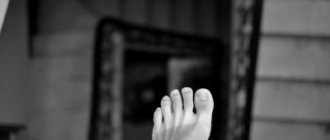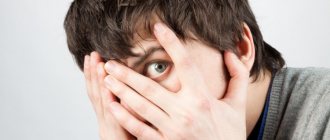Ivan Vdovin
860 1 0
Few people can admit their childhood fears. There are even fewer who can look their fear in the eye. And this is the most key method with the answer to the question of how to stop being afraid of the dark. But it’s business, and you need to be fully prepared if you, of course, want to remove your childhood fears and become even more self-confident.
What Lies Behind the Fear of the Dark
Behind the fear of the dark lies something that we do not know and do not expect. Can be compared with our life. We don't know what will happen tomorrow, and everything can change at any second. Imagine you are alone in the dark and suddenly an image of what you are afraid of appears in front of you. What are your plans? Are you planning to die right away or are you still resisting?
But if you know and understand your fear very well and believe with complete confidence that all evil spirits are the inventions of science fiction writers, you will not be afraid. And with complete confidence you will walk through the dark forest completely alone.
I’ll say it again, it’s not the object itself that we’re afraid of, but the fact that it may appear suddenly and greatly frighten us. And it seems to me that any person will be afraid if he does not have experience interacting with various ghosts, spirits, aliens and so on, what we are afraid of.
What is nyctophobia?
Nyctophobia (less commonly achluophobia ) is a pathological fear of the dark, night time, and dark rooms.
Many people believe that such fear is only characteristic of children, but this is not so.
Most adults are ashamed to admit it . Nyctophobia is one of the most common fears; people of completely different ages suffer from it. 10% of the population experiences paralyzing terror when in a dark room.
This phobia can accompany a person exclusively in childhood, and later simply disappear on its own. It happens that a person has never been afraid of the dark in his life, but suddenly he becomes afraid.
But most often, nyctophobia haunts people from childhood, and in older age it only intensifies. As a rule, it is much easier for children to get rid of a phobia; in adults, fears become more serious.
Do you need to get rid of your fear of the dark?
Let me ask you a question: Are you so afraid of the dark that you even sleep with the light on? If the answer is yes, then you urgently need to work through your fear of the dark. If you just feel uncomfortable in the dark and different thoughts come into your head. Can you bear it? In the second case, I think you don’t have to worry too much.
But with the first example we need to do something. And do it gradually, and not immediately rush into battle. Once I was visiting a friend in the village, and his grandmother was very afraid of the dark. So, when there was no one at home, she slept only with the light on. As a child, she saw something and since then she has not been able to overcome her fear of the dark. And I understand her perfectly.
✅Guide to changing yourself .pdf
Where does the fear of the dark come from?
The phobia of darkness is called nyctophobia, the concept comes from the Greek word nyktos - night. Statistics from the Statistic Brain Research Institute show that 11% of the US population suffers from a fear of the dark. This phobia can be called logical. “Darkness literally impairs our vision, and it is inherently uncomfortable.
“Fear is like pain. Fear appears to protect us from possible harm. So fear makes us more vigilant to prevent possible danger,” says Martin Anthony, a professor of psychology at Ryerson University (Canada). Historically, people were more at risk of attack by predators or enemies when they were in the dark, he explains. Thus, due to evolution, humans have a tendency to be afraid of the dark.
Although fear is natural, it can become a problem if it becomes too intense. Excessive fear of the dark can come from a negative experience, such as being attacked in a dark place. Or it could be caused by something as common as watching a horror movie, says Antony.
Sigmund Freud believed that our fear of the dark arises from childhood trauma due to separation anxiety from our parents, being left alone in dark children's rooms at night.
The profile portal about insomnia No Sleepless Nights writes that the most common causes of phobias are also:
- Surviving life-threatening situations: accidents, fires;
- Sexual or physical abuse in childhood, lack of parental care (for example, when parents are punished by being kept in the dark;
- Assault or abuse.
The Royal College of Psychiatrists (UK) also points out that many factors may play a role, with some people genetically more likely to experience anxiety and others to take drugs, alcohol and stimulants such as caffeine. All of these factors can also lead to increased anxiety levels.
Some mental health problems can lead to irrational fears and worries. And even some physical diseases, such as thyroid disease.
Like many phobias, fear of the dark often goes back to childhood. According to statistics from psychologists, almost 90% of children sooner or later become afraid of sleeping without light. The room is transformed, the child cannot see what he is used to seeing during the day, which means that the space could potentially be fraught with danger.
In 10% of cases, as a person grows up, he never “outgrows” his fear, and the phobia begins to go with him through life.
Experts note that perhaps there are many more people suffering from nyctophobia, because it is difficult for adults to admit their “childish” weakness. Fear of the dark is more often characteristic of people with a rich imagination, who literally “complete” non-existent things themselves. As in the case of self-preservation mechanisms, there are also benefits of a mild fear of the dark, for example, it protects a child from walking along night streets and unlit unfinished buildings.
Adults who are afraid of the dark are also more likely to avoid danger and are less likely to find themselves in dangerous situations. Moderate fear is normal, but only until it develops into irrational panic and begins to interfere with normal life.
And if a weak fear of the dark brings some benefit, then the harm from a strong phobia is very noticeable.
Many nyctophobes sleep with a night light or the TV on, or cannot fall asleep at all until dawn. This affects daily productivity and relationships with loved ones, and also harms health, especially the functioning of the cardiovascular system and hormonal levels.
Of all nyctophobes, women make up approximately 65%, and experts associate this fact with hormonal characteristics. In particular, the emotional state of women is affected by a lack of the hormone melanin.
How to get rid of the fear of the dark
There are two ways. The first is to knock out a wedge with a wedge. That is, if it’s scary in the dark, it means we spend more time in the dark. But, if the fear is very strong, then do not make hasty decisions, but get used to it gradually. For example, if your greatest fear is that you sleep with the light on, then begin to gradually reduce the intensity of the glow.
For example, you can hang a night light with adjustable voltage, from here you can both increase the light and decrease it. So every week, reduce the light intensity a little bit. Do it less and less, the main thing is not to rush.
Then you can start sleeping with the lights off, but with the TV on. Or some movie on the laptop. The main thing is to get used to it gradually. And literally in 2-3 months in a gentle mode you will be able to sleep in complete comfort.
Symptoms and signs
Nyctophobia has the character of attacks that intensify with the approach of darkness .
- cardiopalmus;
- stomach ache;
- pressure surges;
- headache;
- shiver;
- increased sweating;
- unreasonable feeling of cold;
- feeling that the legs have become “woolly”;
- stuttering, even if the person has not observed this before;
- anxiety;
- strong fear;
- panic;
- hand tremors;
- fear can lead to real horror, in which a person can scream loudly, fight hysterically, run headlong, or, on the contrary, hide in a corner;
- neurotic state;
- dizziness;
- sleep disorder, nightmares;
- paranoia.
Fear of the dark after watching a horror movie
The most common fear among impressionable people. Be me by the way too. After watching horror films, you think that this particular woman is going to jump out at you. I remember after the movie “Paranormal Activity” I couldn’t fall asleep normally for a long time, I thought that everything that happened in the film would now happen to me.
Read more: How not to be afraid of anything
This problem can be easily treated with the help of a video that described how the film was made. We need to explain to our subconscious that all this is fiction and a figment of the director’s imagination and there is nothing to be afraid of.
Child's fear
Statistics show that nyctophobia most often develops in early childhood. Up to a year old, the baby is afraid of strangers and loud sounds. At 2-4 years old, a child is frightened by animals and darkness. From the point of view of the instinct of self-preservation, this is considered normal. In the future, parents themselves sometimes provoke the development of fear in children, scaring them for disobedience with various horror stories or allowing them to watch films with bloody scenes of fights and violence before bed.
Child's fear
Important! In order for children to sleep peacefully, the evening family holiday should be calm, filled with positive emotions.
At the ages of 10, 11, 12, 13 years old, children begin to be ashamed of their fear and hide it, fearing ridicule. Playing computer games every day for several hours in a row helps to weaken the fragile child’s psyche.
Teenage girls aged 14, 15 and 16 are more prone to fears than boys. But both of them are afraid of bullying and condemnation from their peers, and withdraw into themselves and their experiences. Unresolved children's problems and various conflicts aggravate the situation.
Tips and tricks for parents:
- do not laugh at children under any circumstances;
- do not make critical comments;
- listen carefully to the child;
- explain that all people are afraid;
- tell your personal story of how to overcome fear;
- discuss how to solve the problem.
Childhood fear
For a small child, you can leave a lamp with soft light on at night and allow him to sleep with his favorite toy. Children should be saturated with positive things: good cartoons, fairy tales, and quiet sleep will bring undoubted benefits to the fragile child’s psyche. It would be good to drink a glass of herbal tea or milk with honey. A constant evening ritual will have a calming effect, and the baby will begin to stop being afraid.
Important! Trusting relationships in the family will help overcome fear and rid children of phobias.
Attentive parents, having noticed the alarming behavior of their baby, should definitely consult a psychologist. Perhaps the child needs treatment, and children's fears are temporary and can be easily corrected. Experts use game techniques and creative tasks to help people forget about the causes of fear.
Fear of the dark, remove in 30 minutes
I have a niece, and when she was 10-12 years old, I eliminated her fear of the dark with the help of psychology. We removed everything that she was afraid of completely and without return. Now she calmly moves around the dark apartment without worrying that someone will scare her.
If you are seriously tormented by the fear of the dark, then contact me, I will quickly remove the fear within 30 minutes and for free
✅Guide to changing yourself .pdf
Name and definition of fear of the dark
Of all the phobias known today, fear of the dark remains the most common among children and adults.
Few people have not experienced fear when suddenly left alone in pitch darkness. Psychologists distinguish between fear and phobia. Real acute fear includes the instinct of self-preservation: there is danger, you need to save yourself or defend yourself. Such a reaction cannot be called a phobia. Neurotic unreasonable fear is already a phobia. A person experiences unaccountable, persistent fear even in a safe situation. Anxiety is accompanied by certain symptoms. That is, phobias are fears expressed more strongly and vividly, which negatively affect a person’s well-being and activities and interfere with his normal life. They are considered a mental disorder. According to statistics, more than 10% of the world's population is susceptible to a phobia called nyctophobia.
By definition, nyctophobia is an uncontrollable fear of a dark room or unlit area. Sometimes nyctophobia is confused with a fear of enclosed spaces. This is wrong. A person suffering from a fear of the dark can safely stay indoors as long as there is light there.
How to get rid of the fear of the dark, advice from a priest
Unfortunately, I cannot say that all our people are believers, but I think everyone has a small piece of faith in God. Precisely in God, but not in religion. In short, the matter of faith is the matter of each of us. And it can be used both for good and destructive.
Let's use it for good. At night, or when you have a strong fear of the dark, read the Lord’s Prayer. Again, I’m not saying whether it works or not, but it’s all about your personal faith in all this. If you sincerely believe, then it will work.
The point here is that if you are afraid of the dark, that something terrible and inexplicable will run out at you, it means that this fear can also be overcome with the help of the inexplicable, or rather prayer. By believing in prayer, you believe in your security and the guardian angels themselves protect you from evil forces. Something like this.
Another way is to work through childhood traumas with a psychologist. What we do is we take fear and plunge into the subconscious into the original situation in which it began to manifest itself and relive everything that happened in the past. Everything is done easily and quickly.
Another option is that you acquired fear from your parents. It was simply passed on to you unconsciously. This is also easy to remove using certain techniques.
Reasons for appearance
The one who is safest is the one who is alert even when there is no danger. (Cyrus)
Often, the emergence of nyctophobia begins in the mother's womb. It is then that the first acquaintance of the future baby with fears occurs. An unborn child feels the mother’s increased anxiety and her often unreasonable strong feelings. Of course, he does not realize or understand what is happening to him and his mother, but the brain and nervous system remembers the mother’s biological reaction to fear. That is, the embryo already has the ability to be afraid, and individual reactions to fear have been developed.
Also, the appearance of fear of the dark depends on social factors, specific developmental conditions, genetic profile, and individual mental characteristics.
Fear of the dark in childhood also arises as a result of the child’s anxiety due to the absence of the mother at the right moments, in his opinion. Already at the age of one year, when the mother even leaves for a short time or moves far away from the child, leaving him in a dark room, he shows signs of anxiety, which transform into fear. As a result, although mothers act formally correctly, children develop their first neuroses. Stress is often aggravated by the overly demanding behavior of parents who do not take into account the characteristics, inclinations and character of the baby. An insufficiently gentle, polite, warm attitude of adults towards a child, especially a mother, contributes to an increased fear of the dark.
Anxious parents not only reinforce, but even intensify the child’s anxiety and fears, ensuring the stable and rapid formation of an anxious type of reaction in their offspring.
One of the typical ways of transmitting fears, according to scientists, is that there is an 80% chance that children will develop a fear of the dark if their parents have such a fear . This is explained by the general constitutional characteristics of the nervous system and the fact that parents always enjoy great authority and between them and the child there is the closest possible emotional contact.
Fear of the dark develops as a result of a strong discrepancy between verbal and nonverbal manifestations. The child perceives about 80% of information non-verbally, focusing on the “language” of the senses. Information entering the subconscious is perceived as completely correct. And although most of it is not realized, it is consolidated on a subconscious level.
Premature avoidance of danger in nyctophobia, which is observed in infancy, indicates congenital or early acquired excessive anxiety. This is often observed in children of sick or elderly parents. Indeed, the development of a “late” child occurs with excessive care and anxiety of parents, which turns into infantility and a feeling of self-doubt in the baby. The only child in the family is also , because a situation where there is someone to talk to and play with leads to a decrease in the amount and intensity of fear. While emotionally stable, developed, young, energetic, cheerful and optimistic parents, the child is less prone to manifestations of anxiety.
The formation and intensity of nyctophobia in childhood is often influenced by the composition of the family. Children growing up in single-parent families are more susceptible to uncertainty and fear. Conflicts in the family also find a peculiar response in a strong fear of the dark.
The occurrence of nyctophobia is usually facilitated by individual characteristics of higher nervous activity: excessive emotional sensitivity, increased susceptibility, vulnerability, vulnerability and impressionability. The highest possible levels of these indicators lead to bright, non-standard imaginative thinking and a clear recording of significant life events. Nervous processes in emotionally sensitive individuals are characterized by inertia and inflexibility, and coupled with a well-developed and active long-term memory, this causes long-term fixation on the object of fear and does not allow one to quickly switch attention.
conclusions
Fear of the dark is some kind of strange thing, it seems to be necessary, but it seems to interfere. If it bothers you a lot, you need to remove it; it won’t go away on its own. The easiest way is to work with a psychologist and understand what he is pointing at. Our psyche is very complex and perhaps the manifestation of fear is like a mark on a map, which the subconscious mind points to for us to pay attention to. We need to figure out what exactly it points to.
Read more: What to do if you are sad and want to cry
Here’s an article about how to stop being afraid of the dark. It may seem to you that the methods for solving the problem are too complicated, but no, fear is a thing that can only be removed with wedges.
Thank you readers for your ratings and reposts!
Please excuse my ERRORS in the text, unfortunately I am a great specialist in psychology, not in literacy)) Sign up for consultations now, I will be happy to help you find happiness in life! Cost 5000-2500 rubles per consultation . Also read reviews about my work. Download now the guide to changing yourself.
Psychotherapy and other treatments
You cannot get rid of scotophobia on your own. Here you cannot do without psychotherapeutic help. It often has to be reinforced with pharmaceutical psychotropic drugs:
- antidepressants (reduce “permanent” tension);
- tranquilizers (calm anxiety, dull fear);
- beta blockers (suppress the production of the stress hormone adrenaline).
There are a number of effective psychotherapeutic techniques to help get rid of scotophobia:
- the most effective is hypnotherapy, solving a problem using suggestion. A competent hypnotherapist, such as Nikita Valerievich Baturin, who thoroughly masters the technique of hypnosis, quickly relieves the obsessive fear of the night and darkness;
- Cognitive behavioral therapy gives good results. During conversations with the client, the psychotherapist finds out the source of the fear of the dark and develops a winning strategy. The specialist teaches the client to “think in a new way,” to look at fear differently, to stop being afraid. Gradually, the psychotherapist “instills” pleasant associations associated with darkness;
- psychoanalysis is effective. The psychoanalyst talks with the client and together “gets to the bottom” of the causes of scotophobia. And then it helps to get rid of fear;
- Group therapy works well. People suffering from scotophobia get together, share their “painful problems”, and together try to find ways to solve the problem.
An unconventional practice, yoga, is considered effective. The main thing here is to find a specialist who can teach meditation techniques and breathing exercises. Soon the forced interest in why the fear of the dark appeared, phobia, as it is scientifically called, will evaporate.
Is it possible to overcome fear?
The development of a phobia of darkness is greatly influenced by impressions from the past. To get rid of a disease, you need to find out what was the root cause of its development. This could be done by:
- anxiety and worry of the mother of the unborn child during pregnancy;
- insufficient attention of parents to a child with a vulnerable psyche;
- overly strict upbringing;
- anxiety and fears of parents;
- growing up in a dysfunctional family;
- hyperemotionality.
By identifying and understanding the nature of fear, you can learn the correct attitude towards it. Individuals with a strong character successfully fight the fear of the dark.
Not everyone can overcome this insidious phobia. Experts can help such people get rid of the fear of the dark.
Manifestation of nyctophobia in adults
The fear of the dark can accompany a person throughout his life. It is much harder for an adult to deal with the fear of the dark than for a child.
This is caused by the following factors:
- the emergence of a feeling of shame due to the existing fear of the dark;
- ignoring the problem;
- refusal of specialist help.
Such actions can subsequently lead to other problems, for example:
- Ekluaphobia is the fear of the dark in painful manifestations.
- Nyctophobia is excessive activity at night. Experts say that this disease makes a person withdrawn and lonely. Nyctophilia is treated by normalizing sleep; patients are taught how to fall asleep correctly and soundly.
- Kleptophobia is the fear of being robbed; as it progresses, this phobia causes a paranoid lack of sleep.
- Nomatophobia is the fear of addressing a person by name. Against the background of the fear of the dark, the patient may lose his voice and, as a result, develop a fear of calling someone for help.
The cause of phobias is a fear of the dark that is not diagnosed in a timely manner. For example, a blenophobe, following his fear of mucus, may develop paranoia of being smeared in the dark, which is why scotophobia begins to develop.
Fear of the dark is much more difficult to overcome in adults, since it is most often diagnosed in the later stages.











